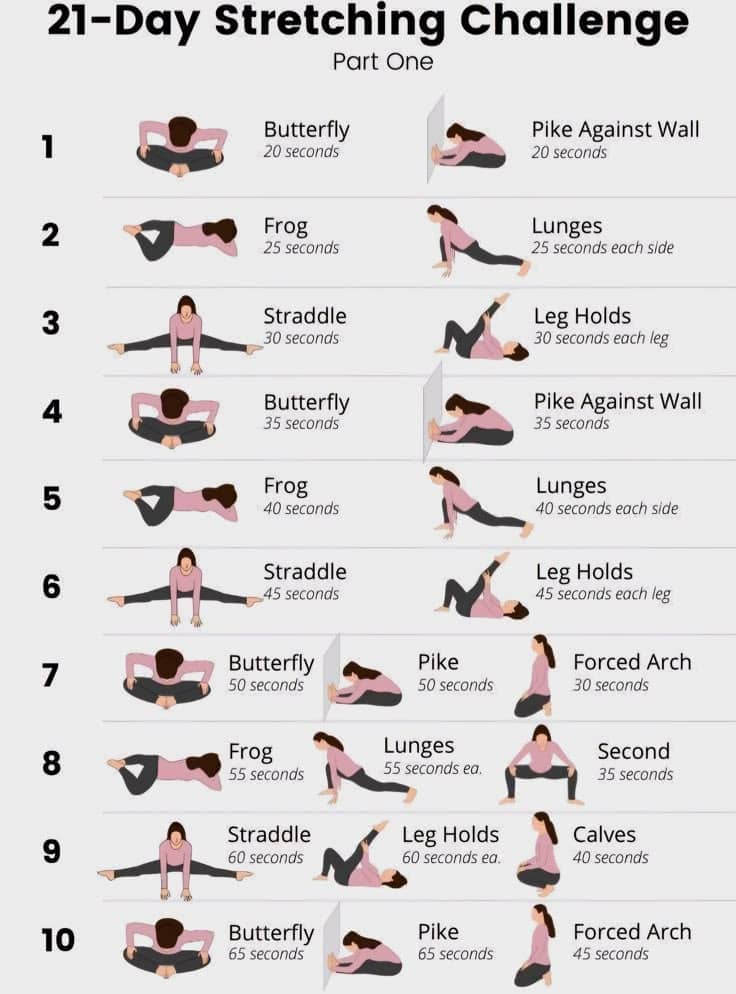The Ultimate 21-Day Stretching Challenge (Part One): Your Comprehensive Guide to Improved Flexibility and Mobility
Are you looking to increase your flexibility, reduce muscle tension, and improve your overall mobility? A well-structured stretching routine can help you reach these goals while also enhancing your posture and range of motion. If you’ve been searching for a day-by-day program to stay motivated and on track, our 21-Day Stretching Challenge (Part One) is the perfect place to begin! In this article, we’ll walk you through everything you need to know—what stretches to do each day, how long to hold them, and the benefits you can expect from each move. By the end of these 21 days, you’ll feel more limber, relaxed, and ready to take on your next fitness challenge.
Table of Contents
- Why a 21-Day Stretching Challenge?
- Important Safety Tips and Disclaimers
- Day-by-Day Stretching Breakdown
- Day 1: Butterfly & Pike Against Wall
- Day 2: Frog & Lunges
- Day 3: Straddle & Leg Holds
- Day 4: Butterfly & Pike Against Wall
- Day 5: Frog & Lunges
- Day 6: Straddle & Leg Holds
- Day 7: Butterfly, Pike, & Forced Arch
- Day 8: Frog, Lunges, & Second
- Day 9: Straddle, Leg Holds, & Calves
- Day 10: Butterfly, Pike, & Forced Arch
- Days 11–21: Progressing and Building Consistency
- Key Benefits of Consistent Stretching
- Additional Tips for Success
- Frequently Asked Questions
- Conclusion
1. Why a 21-Day Stretching Challenge?
Establishing a new habit, such as daily stretching, often requires consistency and repetition. Many experts suggest that 21 days is a sweet spot for turning a new activity into a routine. Over the next three weeks, this stretching challenge will help you:
- Improve flexibility: Gain a greater range of motion in your joints.
- Reduce muscle tension: Alleviate tightness in commonly overused areas like hips, hamstrings, and shoulders.
- Increase circulation: Promote blood flow throughout the body to support muscle recovery.
- Enhance posture: Lengthen and strengthen muscles to help you stand taller and move more gracefully.
- Decrease stress: Experience the calming, mindful benefits of daily stretch sessions.
2. Important Safety Tips and Disclaimers
Before starting any new fitness regimen—including a stretching challenge—it’s essential to keep safety in mind:
- Consult a healthcare professional: If you have any existing medical conditions, are pregnant, or have had recent injuries, talk to your doctor or physical therapist before beginning this program.
- Warm up first: Start each stretch session with a brief warm-up (like marching in place or doing gentle arm circles). Warming up increases blood flow and prepares your muscles and joints for deeper stretches.
- Listen to your body: Never force a stretch if it causes sharp pain or discomfort. It’s normal to feel mild tension, but pain signals you need to ease off.
- Breathe deeply: Inhale and exhale slowly while holding each stretch. Steady breathing helps your muscles relax and maximizes the benefits of each pose.
- Stay hydrated: Proper hydration supports muscle function and recovery.
- Progress gradually: Each day, you’ll slightly increase the duration or complexity of the stretch. Don’t rush it—take the time to let your body adapt.
Remember, everyone’s body is different. The times listed here are guidelines; feel free to adjust them if you need a shorter or longer hold, especially as you progress.
3. Day-by-Day Stretching Breakdown
Below is a comprehensive breakdown of the 21-Day Stretching Challenge (Part One). For each day, you’ll find the recommended stretches, their target hold durations, and a short explanation of how they benefit your body.
Day 1: Butterfly (20 seconds) + Pike Against Wall (20 seconds)
- Butterfly Stretch (20 seconds)
- Target Areas: Inner thighs, hips, and groin.
- How to Perform:
- Sit on the floor with your back straight.
- Bring the soles of your feet together.
- Gently press down on your knees with your elbows for a deeper stretch.
- Pro Tip: Keep your spine tall and your shoulders relaxed. Avoid rounding your back.
- Pike Against Wall (20 seconds)
- Target Areas: Hamstrings and lower back.
- How to Perform:
- Stand facing a wall, about an arm’s length away.
- Place your hands on the wall, hinge from your hips, and lean forward to feel the stretch in your hamstrings.
- Keep your legs straight but not locked.
- Pro Tip: Focus on pushing your hips back rather than just bending from your upper back. You’ll engage your hamstrings more effectively this way.
Why These Stretches?
Starting with shorter holds and simpler poses allows your muscles to gently adapt to daily stretching. The butterfly stretch opens up the hips, while the pike stretch promotes hamstring flexibility—both critical areas for overall lower-body mobility.
Day 2: Frog (25 seconds) + Lunges (25 seconds each side)
- Frog Pose (25 seconds)
- Target Areas: Inner thighs, groin, hips.
- How to Perform:
- Begin on your hands and knees.
- Widen your knees as far as comfortably possible, keeping your ankles in line with your knees.
- Lower your forearms to the floor if you can.
- Pro Tip: Keep your core engaged. This helps stabilize your spine as you open the hips.
- Lunges (25 seconds each side)
- Target Areas: Hip flexors, quadriceps, glutes.
- How to Perform:
- From standing, step forward with one foot.
- Bend your front knee while keeping your back leg extended behind you.
- Lower your hips until you feel a comfortable stretch in the front of the back leg.
- Pro Tip: Ensure your front knee is aligned over your ankle, not too far forward. Switch sides and repeat.
Why These Stretches?
Day 2 emphasizes opening up the hip region, which can become tight from prolonged sitting. By stretching your hip flexors and inner thighs, you’ll find your posture improves and overall movement patterns become smoother.
Day 3: Straddle (30 seconds) + Leg Holds (30 seconds each leg)
- Straddle (30 seconds)
- Target Areas: Inner thighs, hamstrings, lower back.
- How to Perform:
- Sit with your legs spread as wide as comfortably possible.
- Keep your back upright, and gently hinge forward from your hips to deepen the stretch.
- Pro Tip: Place your hands in front of you on the floor. If you can’t go down far, simply work within your comfortable range.
- Leg Holds (30 seconds each leg)
- Target Areas: Hamstrings, quads (depending on how you perform the hold).
- How to Perform:
- From a standing or seated position, lift one leg in front of you, holding it under the thigh or calf.
- Keep your spine straight and core engaged.
- Pro Tip: If you’re more advanced, you can try holding your leg higher or even grabbing your foot. But never strain.
Why These Stretches?
Straddle stretches increase flexibility in the adductors (inner thighs) and hamstrings, which are often tight. Leg holds challenge balance and core strength while further stretching the hamstrings.
Day 4: Butterfly (35 seconds) + Pike Against Wall (35 seconds)
We revisit the Butterfly and Pike Against Wall, but this time we hold each for 35 seconds. Increasing the duration challenges your muscles to adapt to deeper levels of flexibility.
- Butterfly: Maintain a tall spine; use gentle pressure on the knees or thighs.
- Pike Against Wall: Keep your legs straight and hinge from the hips to avoid rounding your upper back.
Day 5: Frog (40 seconds) + Lunges (40 seconds each side)
You’ll recognize these poses from Day 2. Now extend the hold to 40 seconds each to further open your hips and improve lower-body mobility.
- Frog: Keep monitoring your knee positioning—be sure to support your body with your forearms if needed.
- Lunges: Remain mindful of your front knee alignment and maintain a stable core.
Day 6: Straddle (45 seconds) + Leg Holds (45 seconds each leg)
As with Day 3, but with extended hold times:
- Straddle: Keep your chest lifted, and reach forward only as far as your flexibility allows.
- Leg Holds: Challenge your balance by standing tall. If necessary, use a wall for support to stay stable.
Day 7: Butterfly (50 seconds) + Pike (50 seconds) + Forced Arch (30 seconds)
- Butterfly (50 seconds)
- Build upon Days 1 and 4. The prolonged hold further loosens the hip and groin area.
- Pike (50 seconds)
- Target Areas: Hamstrings, calves, lower back.
- How to Perform:
- Sit on the floor with your legs extended in front of you.
- Reach toward your toes while keeping your back as flat as possible.
- Pro Tip: If touching your toes is difficult, rest your hands on your shins or a yoga strap for assistance.
- Forced Arch (30 seconds)
- Target Areas: Arches of the feet, calves, ankles.
- How to Perform:
- Kneel on the floor with your toes tucked under, so you’re stretching the bottoms of your feet.
- Slowly sit back on your heels, feeling the stretch through the arches and calf area.
- Pro Tip: This can be intense if your feet are tight, so start with a shorter hold if needed and gradually increase.
Day 8: Frog (55 seconds) + Lunges (55 seconds each side) + Second (35 seconds)
- Frog (55 seconds)
- Continue the progression from Days 2 and 5, adding more time.
- Lunges (55 seconds each side)
- Spend more time in the lunge to deeply stretch hip flexors and quads.
- Second (35 seconds)
- Target Areas: Inner thighs, hips.
- How to Perform:
- Stand with your feet wider than hip-width apart, toes pointing outward.
- Lower into a squat (often called “second position” in dance) and hold.
- Pro Tip: Keep your chest lifted and your knees tracking over your ankles.
Day 9: Straddle (60 seconds) + Leg Holds (60 seconds each) + Calves (40 seconds)
- Straddle (60 seconds)
- Holding for a full minute can be challenging; focus on deep, slow breathing.
- Leg Holds (60 seconds each leg)
- Keep your core engaged. If necessary, place a hand on a wall for balance.
- Calves (40 seconds)
- Target Areas: Gastrocnemius and soleus (calf muscles).
- How to Perform:
- Stand facing a wall and step one foot back.
- Press your back heel down, keeping that leg straight.
- For a deeper stretch, slightly bend the back knee (which targets the soleus).
- Pro Tip: Switch legs halfway. Calf stretches are crucial if you’re active, especially if you run or walk a lot.
Day 10: Butterfly (65 seconds) + Pike (65 seconds) + Forced Arch (45 seconds)
Pushing endurance further:
- Butterfly (65 seconds): Allow your hips to relax. You might notice significant improvements in your range of motion by now.
- Pike (65 seconds): Keep breathing deeply, focusing on elongating the spine.
- Forced Arch (45 seconds): Continue to be gentle with your feet and ankles, especially if you feel any strong sensations.
11. Days 11–21: Progressing and Building Consistency
While the first 10 days follow a specific schedule (and the accompanying image references Part One of this challenge), the remaining days in your 21-day stretch should gradually increase duration or introduce slight variations of these base stretches. Here’s a general guideline for the last 11 days:
- Increase hold times by 5–10 seconds every few days.
- Add variations such as:
- Twisting: Incorporate a gentle spinal twist in a seated position.
- Extended reaches: Add a side bend in the straddle stretch.
- Deeper lunge variations: For example, dropping your back knee down to the floor and leaning forward gently.
- Combine stretches in mini-circuits: Instead of doing them in a linear fashion, try alternating poses (e.g., do 20 seconds of frog, then 20 seconds of pike, and back to frog for another 20 seconds).
By Day 21, you’ll have spent three weeks consistently improving your flexibility. You should notice improved range of motion, reduced soreness, and possibly better posture and alignment.
4. Key Benefits of Consistent Stretching
- Improved Flexibility and Mobility
Holding stretches regularly helps increase the length of both muscles and tendons, leading to more flexibility and smoother daily movements. - Enhanced Recovery
Whether you’re a runner, cyclist, or simply have tight shoulders from desk work, stretching supports better blood circulation. This can reduce muscle fatigue and soreness. - Better Posture
Many of these stretches open the hips and lengthen the spine, helping to correct the common issue of slouching. - Stress Relief
Stretching can be meditative. Deep, controlled breathing paired with stretching may lower stress levels and help clear your mind. - Injury Prevention
Flexible muscles are less prone to strain. Regular stretching helps prepare your body for more advanced exercises, reducing the risk of injuries.
5. Additional Tips for Success
- Set a Reminder: Consistency is key. Schedule your stretches at the same time daily—morning, post-workout, or evening—to establish a routine.
- Create a Comfortable Environment: Use a yoga mat or soft rug to cushion your joints. Good music or ambient sounds can help you relax and enjoy the moment.
- Stay Hydrated and Nourished: Drinking water throughout the day and maintaining a balanced diet supports muscle health and flexibility.
- Use Props: Yoga blocks, resistance bands, or a sturdy chair can assist you in deeper stretches while maintaining proper form.
- Track Your Progress: Keep a journal or use a fitness app to note improvements. This can include how far you can reach, how you feel, and any changes in soreness.
- Pair Stretching with Other Healthy Habits: Combine daily stretching with short walks, light strength training, or mindfulness practices for an all-around healthy lifestyle.
6. Frequently Asked Questions
Q: Can beginners do this 21-Day Stretching Challenge?
A: Absolutely. This routine is designed to be progressive. If a certain hold time is too long, reduce it to a manageable level and slowly work your way up.
Q: Do I need any special equipment?
A: Generally, no. A yoga mat or a carpeted floor is often enough. You can also use a strap or towel to assist with stretches like the pike if you can’t reach your feet.
Q: How long should each session take?
A: Each daily session can vary. In the beginning, it may only take around 5–10 minutes. As you increase the hold times, sessions might extend to 15–20 minutes or more.
Q: Is it okay to feel sore after stretching?
A: Mild soreness or tightness the next day can be normal, especially if you’re new to stretching. However, sharp or ongoing pain is a red flag—dial back and consult a healthcare professional if it persists.
Q: Can I do these stretches multiple times a day?
A: Yes, but be mindful not to overstretch. Listen to your body and ensure you’re not pushing past safe limits.
7. Conclusion
Embarking on a 21-Day Stretching Challenge (Part One) is a powerful step toward better flexibility, improved posture, and enhanced overall well-being. By following this day-by-day breakdown, you’ll gradually loosen tight muscles, increase your range of motion, and support a more active lifestyle. Remember, the key to unlocking the full benefits of stretching lies in consistency, deep breathing, and attentive listening to your body’s signals.
As you progress through this challenge, don’t forget to celebrate small victories—like touching your toes for the first time or feeling less tension in your hips. These are signs of real progress and a testament to your commitment to personal well-being. Here’s to a more flexible, mobile, and revitalized you in just 21 days!
Disclaimer: The information provided in this article is for educational and informational purposes only and is not intended as health or medical advice. Always consult a qualified health professional before starting any new exercise regimen, especially if you have pre-existing medical conditions or injuries.










